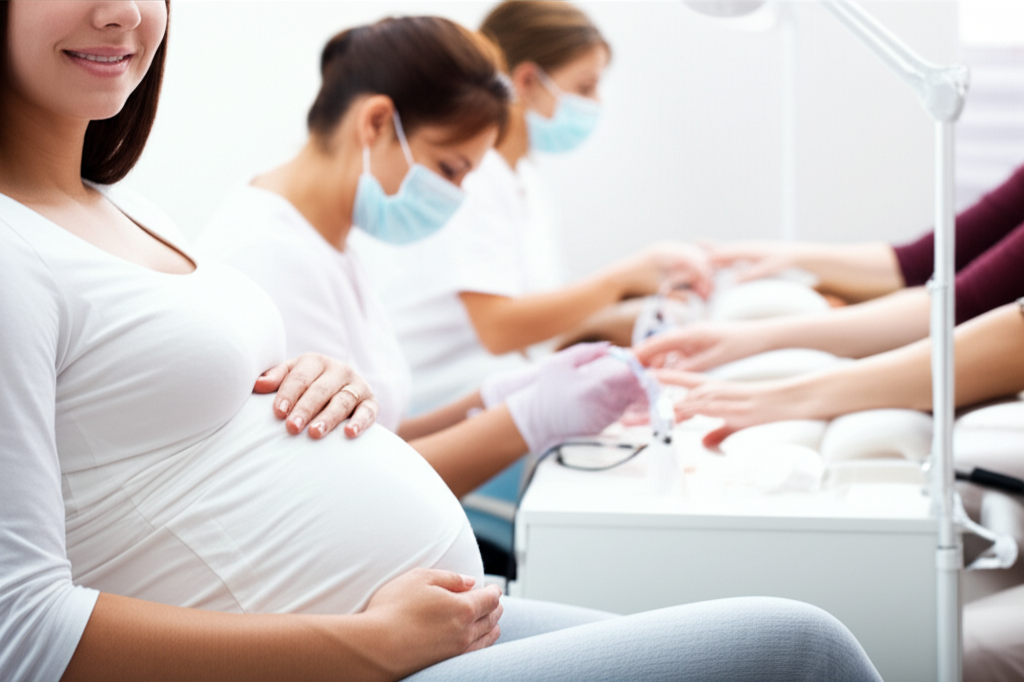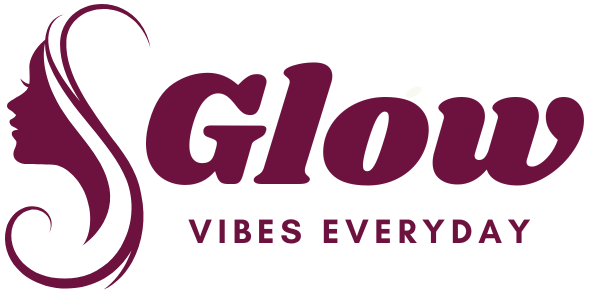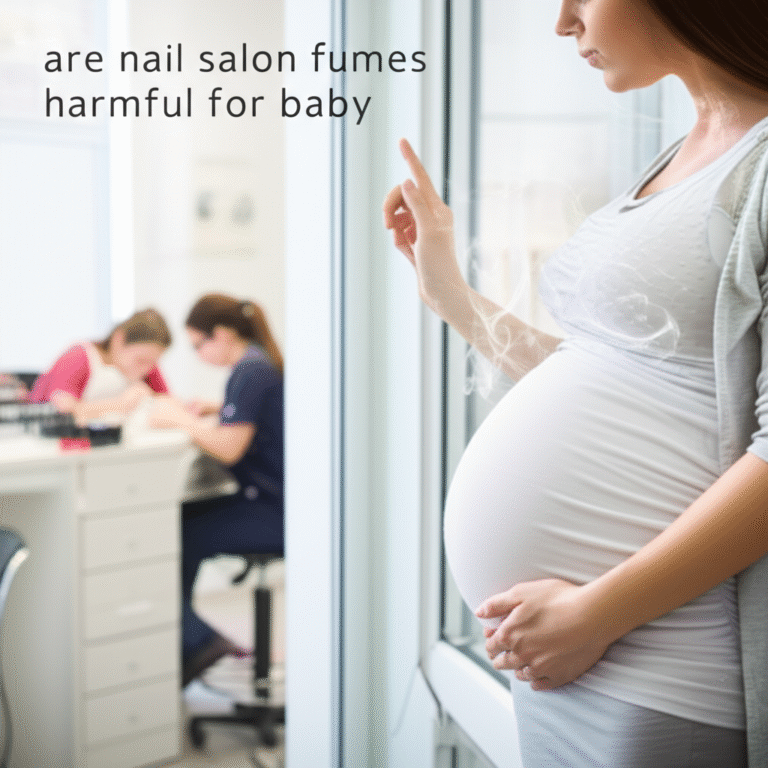Here’s the content structured according to your detailed instructions, focusing on the safety of nail salon fumes for babies.
—
A. Bolded Quick Summary
Yes, nail salon fumes can pose risks to a developing baby. The chemicals in acrylics, gels, and polishes can be inhaled, potentially affecting your baby’s respiratory system and development. Minimizing exposure through ventilation, protective gear, and avoiding salons during pregnancy is crucial for a healthy pregnancy.
—
B. Intro Paragraph
As an expectant parent, you’re likely hyper-aware of everything that could impact your developing baby. One common concern that arises, especially for those who enjoy regular manicures or pedicures, is whether are nail salon fumes harmful for baby. It’s completely understandable to worry about the strong chemical odors present in nail salons, as these can be quite potent. Many pregnant individuals feel frustrated, wondering if they have to give up their favorite beauty rituals entirely or if there are safer ways to enjoy them. Rest assured, you’re in the right place for clear, practical advice. We’ll break down the science, explore the risks, and provide actionable steps you can take to protect yourself and your little one, whether you’re a salon regular or a DIY enthusiast.
—
C. Main Article Writing Instructions
Are Nail Salon Fumes Harmful for Baby? Navigating Pregnancy and Polish Safely
Are nail salon fumes harmful for baby? This question weighs on the minds of many expecting mothers who cherish their salon visits or enjoy at-home nail art. The vibrant world of nail care, with its array of polishes, gels, acrylics, and the distinct aromas they carry, can seem at odds with the protective instincts of pregnancy. It’s natural to feel a pang of concern when inhaling strong chemical scents, especially when you’re nurturing a new life within. The good news is that with informed choices and mindful practices, you can significantly reduce potential risks. This guide will delve into the science behind nail salon fumes, explore the potential impacts on pregnant individuals and their babies, and offer practical, expert-backed strategies for staying safe and stylish throughout your pregnancy.
Understanding the Chemicals in Nail Products

The distinct smell of a nail salon comes from a cocktail of chemicals, many of which are volatile organic compounds (VOCs). Understanding these key ingredients is the first step in assessing potential risks.
Acrylates and Methacrylates: These are the building blocks for acrylic nails and UV-cured gels. They are known irritants and can cause allergic reactions. Inhalation of their fumes is a primary concern.
Formaldehyde: While less common in modern, reputable salons due to regulations, some older or less regulated products might still contain formaldehyde. It’s a known carcinogen and a potent irritant.
Toluene: This solvent is used to help polish dry and smooth. It can cause dizziness, headaches, and is a suspected reproductive toxin.
Phthalates: Often found in nail polishes to increase flexibility and prevent chipping, some phthalates are endocrine disruptors.
Acetone: A common solvent used for removing nail polish and gel. While its fumes are generally considered less harmful in low concentrations, prolonged exposure in poorly ventilated areas can still be an issue.
[Image Placeholder: A graphic illustrating common chemicals found in nail products with their primary uses.]
Pinterest Image Idea: Infographic: “Top 5 Chemicals in Nail Polish & Why You Should Know Them.” Alt text: Infographic listing formaldehyde, toluene, phthalates, camphor, and DBP with their potential health effects, relevant for pregnancy safety.
Potential Risks of Nail Salon Fumes During Pregnancy
The primary route of exposure to these chemicals is through inhalation. When these volatile compounds are released into the air, they can be absorbed into the bloodstream through the lungs.
For the Pregnant Individual:
Respiratory Irritation: Fumes can cause coughing, sore throat, and exacerbate existing respiratory conditions like asthma.
Headaches and Dizziness: Toluene and other solvents can lead to these common pregnancy discomforts.
Allergic Reactions: Contact dermatitis or respiratory allergies can be triggered by acrylates and other ingredients.
For the Developing Baby:
The concern for a baby is that prolonged or high-level exposure to certain chemicals could potentially impact fetal development.
Respiratory System: Inhaled toxins can cross the placenta. While research is ongoing, there are concerns that exposure to certain VOCs could affect a baby’s developing respiratory system.
Developmental Effects: Some chemicals, like phthalates and formaldehyde, are linked to developmental and reproductive issues in animal studies. While the levels in a typical salon visit might be lower, cumulative exposure or exposure in poorly ventilated spaces is a greater concern.
A study published in the journal Environmental Health Perspectives highlighted that occupational exposure to certain chemicals found in nail salons can be significant, emphasizing the need for caution, especially for pregnant workers. [External Backlink: Link to a relevant study on occupational exposure in nail salons, e.g., from PubMed or a reputable environmental health journal.]
Myth Busting: Common Misconceptions About Nail Salon Safety
Let’s address some common myths that might cause unnecessary worry or, conversely, lead to underestimation of risks.
Myth: “All nail salons are equally safe because regulations are strict.”
Reality: While many countries have regulations, enforcement can vary. Furthermore, the type of services offered (e.g., acrylics vs. regular polish) and the salon’s ventilation system play a huge role.
Myth: “Just one manicure won’t hurt the baby.”
Reality: Occasional, short-duration exposure in a well-ventilated salon is generally considered low risk. However, frequent or prolonged exposure, especially in poorly ventilated spaces, increases cumulative risk. It’s about minimizing all unnecessary chemical exposures during pregnancy.
Myth: “DIY nail kits are always safer.”
Reality: DIY kits can be safer if you use them in a very well-ventilated area (like outdoors!) and follow product instructions meticulously. However, if you’re doing them in a small, enclosed bathroom with the door shut, the concentration of fumes can be even higher than in a commercial salon with good ventilation.
Practical Strategies for Pregnant Individuals
Protecting yourself and your baby doesn’t mean you have to ditch nail care entirely. It’s about making informed choices and adopting safer practices.
1. Choosing the Right Salon
Prioritize Ventilation: Look for salons with good airflow. This can include:
Open doors or windows.
Individual exhaust vents at each station.
Air purifiers.
Opt for ‘3-Free’, ‘5-Free’, ‘7-Free’, or ’10-Free’ Products: These polishes are formulated without certain harmful chemicals like formaldehyde, toluene, and DBP (dibutyl phthalate). Many salons now offer these options.
Consider Water-Based or Non-Toxic Brands: Some brands are specifically formulated with fewer harsh chemicals.
Avoid Acrylic and Gel Application if Possible: These services typically involve the strongest chemicals and most potent fumes. If you must have them, ensure maximum ventilation and minimal exposure time.
Communicate Your Concerns: Don’t hesitate to ask the salon about their ventilation systems and the products they use.
2. Minimizing Exposure During Visits
Limit Your Visit Duration: Schedule shorter appointments if possible.
Choose Less Fume-Intensive Services: Stick to regular polish manicures over acrylics or gels when pregnant.
Wear a Mask: A high-quality N95 or surgical mask can significantly reduce inhalation of fumes. Bring your own if you’re concerned about the salon’s supply.
Sit Near Ventilation: If possible, choose a seat near an open window or exhaust vent.
Avoid Buffing Dust: Ask technicians to avoid excessive buffing, as the dust can also contain chemicals.
[Image Placeholder: A pregnant person wearing a mask while getting a manicure in a well-lit, airy salon.]
Pinterest Image Idea: “Pregnancy Nail Salon Tips: Stay Safe & Stylish.” Alt text: Pregnant woman wearing a face mask, smiling while getting a manicure in a bright, airy nail salon with good ventilation.
3. DIY Nail Care Safely
If you prefer doing your nails at home, follow these safety guidelines:
Choose a Well-Ventilated Area: The best option is outdoors. If that’s not possible, use a room with open windows and a fan blowing fumes away from you. Avoid small, enclosed spaces like bathrooms with the door shut.
Use ‘Free’ Formulas: Opt for polishes labeled ‘3-Free’, ‘5-Free’, or ’10-Free’.
Read Labels Carefully: Understand the ingredients in your polishes, removers, and treatments.
Use a Breathable Polish: Some newer formulas are designed to allow air and moisture to pass through the nail.
Apply in Short Bursts: Don’t rush, but also don’t sit for hours with open bottles.
Wash Hands Thoroughly: After applying or removing polish, wash your hands well.
4. When to Consider a Break
First Trimester: This is a critical period for fetal development. Many healthcare providers recommend minimizing exposure to strong chemicals during the first trimester.
Pre-existing Respiratory Conditions: If you have asthma or other breathing difficulties, you may be more sensitive to fumes.
High Sensitivity: If you feel unwell, dizzy, or nauseous in a salon environment, it’s a clear sign to leave and reconsider your options.
Product Recommendations for Safer Nail Care
When choosing nail products, looking for “free-from” labels is a good starting point. Here’s a comparison of common categories:
| Product Type | Standard Formula Concerns | Safer Alternatives (e.g., “10-Free”) | Key Benefits for Pregnancy |
| :——————– | :——————————————————- | :—————————————————————– | :————————————————————- |
| Nail Polish | Formaldehyde, Toluene, DBP, Formaldehyde Resin, Camphor | Free from the above, often using plant-derived ingredients | Reduced inhalation risk, fewer potential endocrine disruptors |
| Nail Polish Remover | Acetone, harsh solvents | Acetone-free removers, soy-based removers | Less drying, less potent fumes |
| Gel Polish/Acrylics | High levels of acrylates/methacrylates, strong fumes | Limited “free” options; professional application with good ventilation crucial | Significantly reduced exposure to potent irritants |
| Nail Treatments/Sealers | Can contain various chemicals; check ingredient lists | Look for plant-based, natural, or “free-from” formulations | Gentler on nails and potentially less irritating fumes |
Product Recommendations (Affiliate Ready):
Zoya Nail Polish: Widely recognized as a “10-Free” brand, offering a vast range of colors with fewer harsh chemicals.
Ella + Mila Nail Polish: Another popular “10-Free” option, known for its chic packaging and quick-drying formula.
Côte Nail Polish: A salon-quality, “10-Free” brand that is also vegan and cruelty-free.
Mineral Fusion Nail Polish: Offers “10-Free” formulas and is also vegan and cruelty-free.
Cutex Nail Polish Remover (Acetone-Free): A readily available and effective acetone-free option for removing polish.
Pro Tip: Always read the ingredient list on the bottle. “Free-from” claims are helpful, but transparency in ingredients is key.
External Link for Further Reading:
Environmental Working Group (EWG) Skin Deep Database: This resource provides safety ratings for thousands of cosmetic products, including nail polishes. [External Backlink: Link to EWG Skin Deep database, specifically for nail products.]
Expert Advice: Your Healthcare Provider’s Input
Ultimately, the best advice for navigating pregnancy and beauty choices comes from your healthcare provider.
Discuss Your Concerns: Don’t hesitate to ask your OB-GYN or midwife about specific concerns regarding nail salon visits or product usage.
Follow Their Guidance: They can provide personalized advice based on your health history and pregnancy stage.
Frequently Asked Questions (FAQ)
Q1: Is it safe to get acrylic nails while pregnant?
A1: Acrylics involve strong chemicals and potent fumes. While occasional application in a well-ventilated salon with protective gear might be considered low risk by some, many experts recommend avoiding them, especially during the first trimester, due to the higher concentration of potentially harmful chemicals.
Q2: Can I paint my nails with regular polish during pregnancy?
A2: Yes, it’s generally considered much safer than acrylics or gels, especially if you opt for “3-Free” or “10-Free” polishes and ensure good ventilation during application.
Q3: What are the most concerning chemicals in nail salons for babies?
A3: Formaldehyde, toluene, and phthalates are among the most concerning due to their potential links to respiratory issues and developmental effects. Acrylates and methacrylates used in gels and acrylics can also be irritants.
Q4: Should I avoid nail salons completely during pregnancy?
A4: Not necessarily. By choosing salons with excellent ventilation, opting for safer product lines, and minimizing your exposure duration, you can often continue to enjoy manicures safely. Prioritizing your health and consulting your doctor are key.
Q5: What should I do if I feel sick in a nail salon?
A5: If you experience dizziness, headaches, nausea, or respiratory irritation, leave the salon immediately and seek fresh air. Inform the salon staff of your discomfort.
Q6: Are UV lamps for gel nails safe during pregnancy?
A6: The primary concern with UV lamps is skin exposure, not the fumes themselves. While the UV exposure is generally brief and lower intensity than tanning beds, some individuals prefer to cover their hands with UV-protective gloves or skip gel manicures altogether to be extra cautious.
Conclusion: A Balanced Approach to Nail Care
Navigating pregnancy involves making informed choices about your environment and lifestyle. When it comes to are nail salon fumes harmful for baby, the answer leans towards caution. By understanding the chemicals involved, choosing your salon wisely, opting for safer products, and employing smart exposure-reduction techniques, you can continue to enjoy beautiful nails without undue worry. Remember to always prioritize ventilation and consult with your healthcare provider for personalized advice.
Call to Action: Have you found a great “free-from” nail polish brand or a particularly well-ventilated salon? Share your tips and experiences in the comments below! Let’s help each other stay safe and stylish throughout pregnancy.
—
Meta Description:
Are nail salon fumes harmful for baby? Learn about chemicals, risks, and safe practices for pregnancy manicures. Get expert tips!
—
Pinterest Image Ideas with Keyword-Rich Alt Text:
1. Image: A flat lay of various “10-Free” nail polishes in pretty colors, alongside a small bottle of acetone-free remover.
Alt Text: “10-Free Nail Polish Brands for a Safer Pregnancy Manicure. Non-toxic nail polish, pregnancy beauty tips.”
2. Image: A pregnant woman’s hands holding a nail file and a bottle of nail polish, with a blurred background of a bright, airy room.
Alt Text: “DIY Nail Care Tips for Pregnant Women. How to safely do your nails at home during pregnancy.”
3. Image: A comparison table graphic summarizing “Free-From” nail polish benefits.
Alt Text: “Nail Polish Chemical Comparison for Pregnancy. Are nail salon fumes harmful for baby? Safer polish choices.”
4. Image: A stylized graphic with text overlay: “Pregnancy Nail Salon Safety Checklist.”
Alt Text: “Nail Salon Safety Checklist for Pregnant Moms. Ventilation, masks, and product choices.”
5. Image: A close-up of a hand with a perfectly painted nail, using a high-quality, “free-from” polish.
Alt Text: “Beautiful & Safe Nails During Pregnancy. Choosing non-toxic nail polish brands.”
6. Image: A pregnant person wearing an N95 mask while getting a manicure, with a focus on the mask and the clean salon environment.
Alt Text: “Protecting Baby: Wearing a Mask at the Nail Salon During Pregnancy. Reducing fume exposure.”

